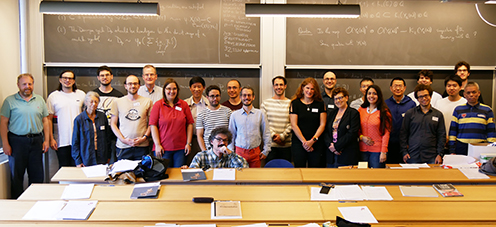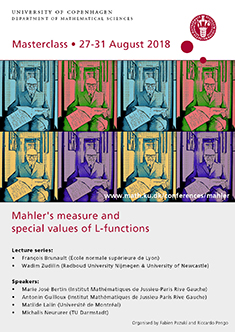Masterclass: Mahler measures and special values of L functions
University of Copenhagen, 27-31 August 2018
This Masterclass is meant to illustrate to young researchers the latest developments in the study of special values of L-functions and its connection to Mahler’s measure, polylogarithms, hypergeometric functions and K-theory.

The book:
The contents of the lectures by François Brunault and Wadim Zudilin have been gathered and expanded in the book "Many variations of Mahler measures. A Lasting Symphony" to be published in May 2020 by the Australian Mathematical Society Lecture Series.
Prerequisites and references:
The courses will require only a basic background in algebraic number theory and algebraic geometry and will be as self-contained as possible.
For a detailed list of references and preliminary reading we kindly refer to this PDF file.
Lecture series:
• François Brunault (École normale supérieure de Lyon)
• Wadim Zudilin (Radboud University Nijmegen)
Speakers:
- Marie José Bertin (Institut Mathématiques de Jussieu-Paris Rive Gauche)
- Antonin Guilloux (Institut Mathématiques de Jussieu-Paris Rive Gauche)
- Matilde Lalín (Université de Montréal)
- Michalis Neururer (TU Darmstadt)
Schedule:
| Monday | Tuesday | Wednesday | Thursday | Friday | |
| 09.00-10.00 | Zudilin | Brunault | Zudilin | Brunault | Zudilin |
| 10.00-10.30 | Break | Break | Break | Break | Break |
| 10.30-11.30 | Brunault | Zudilin | Brunault | Zudilin | Brunault |
| 11.30-13.00 | Lunch | Lunch | Lunch | Lunch | Lunch |
| 13.00-14.00 | Bertin | Guilloux | Free Afternoon | Neururer | Lalín |
| 14.00-14.30 | Break | Break | Break | Break | |
| 14.30-17.00 | E/D session | E/D session | E/D session | E/D session |
Note: "E/D session" stands for "Exercise/Discussion session".
Abstracts:
François Brunault: Mahler measures, regulators and modular forms
The first lecture will be devoted to the construction of Beilinson's regulator for $ K_2 $ of algebraic curves and their function fields, with an emphasis on explicit formulas. We will give the definition of tame symbols and their links with residues. Following Boyd, Deninger and Rodriguez Villegas, we will explain how to use Jensen's formula to express the Mahler measure of a two-variable polynomial in terms of regulators for the corresponding curve.
More generally, we will explain how to define Deligne cohomology of complex algebraic varieties and discuss some cases where the differential forms can be made explicit. We will also give a brief survey of the properties of motivic cohomology and the definition of $L$-functions of varieties over number fields. Armed with this machinery, we will explain Deninger's method and its variants to relate multivariate Mahler measures to $L$-values in the framework of Beilinson's conjectures, generalizing the case of curves.
We will next explain how modular methods can be used to tackle particular cases of Boyd's conjectures on Mahler measures. Specifically, we will describe Beilinson's construction of the Eisenstein symbols (an algebraic version of Eisenstein series) in the motivic cohomology of elliptic curves. This construction turns out to be very useful in the case of modular curves and their associated universal elliptic curves, which we will also discuss. Using this, we will define the regulator integrals and give their main properties.
After a survey of known results and conjectures on multivariate Mahler measures, due to many people, we will explain the method initiated by Rogers and Zudilin to compute these regulator integrals in terms of $L$-values, first in the simple case of the Boyd-Deninger polynomial $x+1/x+y+1/y+1$, corresponding to an elliptic curve of conductor $15$, and then in greater generality for higher weight modular forms. As Neururer will explain in his talk, this leads to new proofs and generates new identities for Mahler measures of universal elliptic curves. We will explain the expected properties of the modular forms appearing in the formulas for regulator integrals. Finally, we will focus on some methods to find "nice" equations for powers of universal elliptic curves.
Wadim Zudilin: Many variables of Mahler measures
The course starts with some basics in algebraic number theory and a historical account of the Mahler measure of univariate polynomials/algebraic numbers.
The review includes
We then proceed to some partial resolutions of Lehmer's problem, due to Smyth, Dobrowolski and others, and to a related problem of Odlyzko and Serre about discriminants of polynomials.
Though the multidimensional generalization given by Mahler in the 1960s was targeted at its usefulness in transcendental numbers, potential applications of the multivariate Mahler measure in Lehmer's problem and a peculiar range of this generalized characteristic have made it a subject of independent study.
We conclude the course
Marie José Bertin: Mahler measure and L-series of $K3$ hypersurfaces
Thanks to Deninger who guessed (1996) the first relation between the logarithmic Mahler measure of a $2$-variable polynomial defining an elliptic curve and the L-series of the same elliptic curve, namely
\[(1)\,\,\,\,\,m(x+\frac{1}{x}+y+\frac{1}{y}+1)=\frac{15}{2\pi^2}L(E_{15},2), \]
Boyd investigated (1998) numerous families of polynomials, proving or conjecturing lots of formulae Deninger-like.
In particuliar, he and
In my
After a brief recall of my former results and techniques, using essentially families of such surfaces, I'll revisit these results in order to get quicker proofs leading more easily to new results. One of my aims is to understand why we obtain, in the same family, formulae such as
\[(2)\,\,\,\,\, m(x+\frac{1}{x}+y+\frac{1}{y}+z+\frac{1}{z}-2)=4\frac{|\det T_{Y_2}|^{3/2}}{4\pi^3}L(Y_2,3), \]
\[(3)\,\,\,\,\, m(x+\frac{1}{x}+y+\frac{1}{y}+z+\frac{1}{z}-10)=\frac{4}{9}\frac{|\det T_{Y_{10}}|^{3/2}}{4\pi^3}L(Y_{10},3)+d_3. \]
Here $d_3$ denotes the Dirichlet $L$-series $d_3:=\frac{3\sqrt{3}}{4\pi} L(\chi_{-3},2)$ and $L(Y_k,s)$ the $L$-series of the $K3$-hypersurface defined by the Laurent polynomial $x+\frac{1}{x}+y+\frac{1}{y}+z+\frac{1}{z}-k$ with $T_{Y_k}$ as transcendental lattice.
Precisely, since in the same family, we obtain either results of type $(2)$ or of type $(3)$, where the Dirichlet term is often of the form $rd_3$, $r\in \mathbb Q$, what is the role of the Newton polytope of the family ( in the above examples, all the faces of the polytope have $d_3$ as Mahler measure)?
You can find the slides for the Bertin talk here.
Antonin Guilloux: Mahler measure of exact polynomials and the volume function.
Matilde Lalín: Identities of Mahler measures via regulators
We will survey on some of the identities that can be proven by exploiting the relationship between Mahler measure and the regulator. These involve mostly elliptic curves, but also some recent results with higher genus curves that were originally proven by Bertin and Zudilin with different methods.
You can find the slides for the Lalín talk Lalín talk here.
Michalis Neururer: Mahler measures of elliptic surfaces
The (logarithmic) Mahler measure of a polynomial $P$ in $n$ variables is defined as the mean of $\log \lvert P \rvert $ restricted to the real n-torus.
In 1997 Deninger noticed
In the following
In my
You can find slides for the Neururer talk Neururer talk here, and you can also read a summary of the talk here.
Financial support:
The conference is funded by the Faculty of Science of the University of Copenhagen.
We will only be able to provide funding for the speakers.
Venue(s):
The Masterclass will take place at the Department of Mathematical Sciences of the University of Copenhagen. The rooms for all the classes and the talks will be:
Auditorium 10, from Monday to Thursday;
Auditorium 8 on Friday.
There will be a beer tasting in the lunch room (04.4.19) on the fourth floor at 18.30 on Monday. There will also be a conference dinner at 20:30 on Thursday, which will take place at Restaurant Omar (Refnæsgade 32, 2200 København N).
Registration:
The deadline for registering was July 27, 2018.
Registrations are now closed.
Public transportation
Tickets and passes for public transportation can be bought at the Copenhagen Airport and every train or metro station. You can find the DSB office on your
Organised by Fabien Pazuki and Riccardo Pengo.

